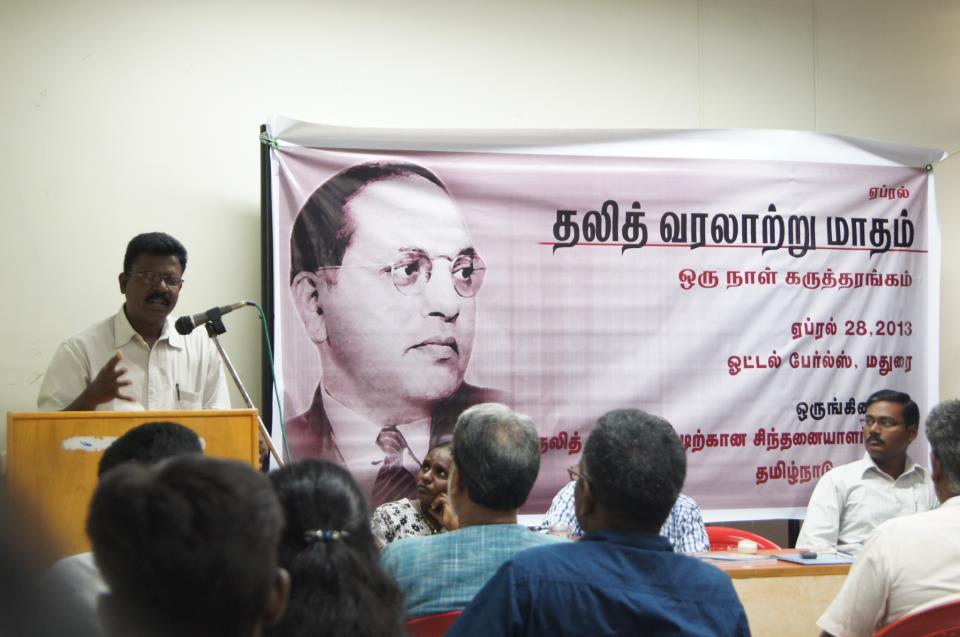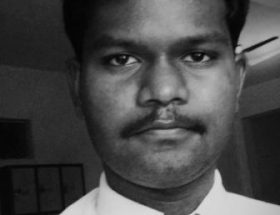Struggles of the Scheduled Caste Liberation Movement (SCALM) as the Strengths to be Agents of Dalit History
(Transcript of the Speech delivered at the Intellectual Circle for Dalit Actions’ Meet on 28th April, 2013, in Madurai)
Anbuselvam
100 years ago Dr. Ambedkar left India on 15th June 1913 for studies at Columbia University, becoming the first Indian untouchable to do so. Dr. Ambedkar’s beloved professor, Dr. John Dewey, helped him formulate his views on democracy based on an ideal society that espoused holistic values. Let us celebrate and recognize the past history of Dalits in the new era of “Dalit History Month” in Madurai. My thanks to the ICDA (Intellectual Circle for Dalit Actions) for the seminar they arranged during the Dalit History Month on 2013 April 28.

Many have used different criteria to understand and analyse the cumulative experiences of the history of the Dalit Movement that came into existence in Tamil Nadu in the past two decades. The so-called Marxist, Periyarist, Dravidianist and Revolutionist understandings of Dalit movements arise out of such judgments or conceptualizations. Let me share the context from which I try to understand the emergence of the Scheduled Caste Liberation Movement (SCALM).
The Dalit political movements that took off with Ambedkar, took deep roots in the Tamil soil due to the efforts of many leaders like Pandit Ayodhidasar, Rettamalai Srinivasan, N. Sivaraj, Annai Meenambal, and many of the SCF leaders like Pallikonda Krishnasamy, Melakkal Muhammed Bilal, K.P.S.Mani and others. Towards the end of the 19th century and in the beginning of the 20th century when the Dravidian movements and Congress organizations were propagating aloud their fraudulent social changes, the spirited rise of these leaders completely changed the political history of the state.
We cannot but acknowledge the role of the Scheduled Caste Federation (SCF), Independent Labour Party (ILP) and Republic Party of India (RPI) political movements in Maharashtra that greatly awakened the contemporary thundering atmosphere in the untouchables of Tamilnadu. The political history of the disappointed and duped Dalits who trusted the Congress and Dravidian parties for half a century was sidelined. Particularly, the representatives of the Dalits L. Ilayaperumal who trusted the Congress had to meet continuous disrespect and were treated like curry leaf. Vai. Balasundaram, A.Sakthidasan who trusted the Dravidian parties had the same bitter experience.
After the 1975 emergency both left their respective parties and realised their own autonomous space within the struggles of the Dalit community. It was only then, when they displayed a sense of shame and self-respect, that they came to be known as contemporary Dalit leaders. L. Ilayaperumal who came out of the Congress formed the ‘All India Human Rights Party‘ and Vai. Balasundaram, who came out of the Dravidian party, formed ‘Ambedkar Makkal Iyyakkam‘ in 1977. It was in this atmosphere that L. Ilayaperumal, Sakthidasan (RPI), Devakottai Dr. M. Subramaniam, Vai. Palanivelu, Kodikkal Chellappa and Dalit Gnanasekaran joined together in 1988, and started the Scheduled Caste Liberation Movement (SCALM). In the heat of starting it, they organized a very successful first state conference at Chennai on 21.8.1988. Bahujan Samaj Party leader Kanshi Ram addressed a rally of more than one million Dalits assembled there. “That more than the fact that Dalits of Tamil Nadu have come together under a single banner of SCALM, our true victory lies in the fact that all of them have come out of the dominant political parties that were cheating us all along.” After this conference, they were fast moving with the task of strengthening SCALM. The caste riots spearheaded by Vanniyars in the northern districts were the battleground for a strong struggle by SCALM. They strengthened SCALM, region-wise in the southern districts.
The Political Impetus of 1989-90
When we demarcate the history of the SCALM movements in Tamil Nadu, we have to consider them as pre and post 1989. In the same period, the election atmosphere in Tamil Nadu weakened SCALM movements and was responsible for the ‘Bodi riots.’ At the same time, it was also the period of the downfall of the top political leaders of the Dalit movements and the beginning of the new era of the rise of younger generation. This period can certainly be called a period that taught some lessons.
In 1989, the caste clashes that took place at Bodinayakanoor, Keezhakodumbanur (Paramakkudi), were converted into southern riots by the then government. Both ‘Dravida Munnetra Kazhagam‘ (DMK) and ‘Anna Dravida Munnetra Kazhagam‘ (AIDMK) made capital out of these riots for their own political gains.
The SCALM held a meeting at Madurai on 19.9.1989, condemning the government’s attitude in the handling of the Bodi riots. Ten such resolutions were passed in the meeting. Struggle against the Vanniyars, agitation condemning the Villupuram riots, and festival of initiation into Dhamma Dheeksha under the leadership of A.Sakthidasan and Mu. Sundararajan, the brutal murder of a schoolboy at Kodumbanoor, meeting of all the leaders at Palayamkottai, demonstration against non-implementation of the L. Ilayaperumal Committee Report and many such struggles were organized by SCALM. In this situation, the parliamentary election in 1989 brought a big setback.
Instead of calling it a setback, it should be called a planned demolition of Dalit awakening and rise. Since SCALM leaders L. Ilayaperumal, A.Sakthidasan, Vai. Balasundaram and S.P. Raj were also in mainstream politics, many parties approached them easily. These leaders put themselves to shame by supporting these political parties and campaigning for them.
DMK created a compulsion and extended an invitation through Se.Kuppusamy, Nanjil Manoharan and Sathik Batsha to SCALM that it should support and work for DMK during the elections. Congress also created a mediator through Buta Singh as L. Ilayaperumal was a supporter of the Congress. As usual, he supported the Congress, which was in alliance with DMK. SCALM promised to support DMK, but RPI differed from it and took the stand of secretly supporting the AIADMK. Because of this, friction arose among the SCALM leaders. L.Ilayaperumal wrote a letter condemning A.Sakhtidasan in his magazine ‘Jothi‘. A.Sakthidasan began to explain his stand with the help of Mail Munusamy and Dinamani. Problems arose in getting the joint support of C. Veeramani of ‘Tamilnadu Arundhathiyar Sangam‘, G. Moorthy, ‘Bharathiya Kudiyarasu Katchi’ and Mu. Sundararajan. SCALM became very weak and had a setback because of such contradictions.
Since quarrels and misunderstandings arose because of the involvement of SCALM in elections, the younger leaders were highly dissatisfied. Particularly Devendhira Kula Vellaalar Sangam, which made an alliance with the Vanniyars, commented, ‘All the Paraiah leaders of the Northern districts came here and completely confused us. They could have as well castrated us (politically).’
After the elections, although it appeared that SCALM was left in the lurch or a desert; here and there a few activities were still carried on. A few dissatisfied leaders came out of it. Dalit Gnanasekaran, who was spearheading the struggle against naming a district as Pasumpon Thevar Thirumaganar district, started the ‘Dalit Liberation Movement’. He consolidated it in 1989. This movement which involved itself in Allalaperi riots near Kariyapatti in August 1990 expanded its area of action to Madurai, Ramnad, Sivagangai, Dindigul, Karur and Salem districts.

In the same period, a new kind of foggy smoke began to engulf the Dalit villages in the Southern districts. The Dalit shooting stars, which were looking forward to the centenary of Babasaheb Ambedkar, began to stun and rattle the spacecraft of dominance. At this time, a new era of Dalit youth began to emerge. In 1983, Bharatiya Dalit Panthers started by comrade Malaichamy, Vellore David, Avaniyapuram Ingulab and others under the leadership of Savita Ambedkar, slowly began to familiarize themselves with the masses. In those days, there was no leader who did not identify himself with the Dalit Panther Movement. While Dr. Krishnasamy was working in the student wing, S.T. Kalyanasundaram, Avaniapuram Ingulab, Dr. Dhyanchand Carr, Melur Sakthivel (Atralarasu) were engaged in various struggles. When Malaichamy died in 1989 Thol. Thirumavalavan, who was agitating in the field struggles as a Dalit intellectual and theoretician, accepted the leadership at the condolence meeting for Malaichamy. At the same time the caste Vanniyar people created caste violence against Dalits in Cuddalore and Villupuram districts.
The Dravidian Brahmanism divided the Dalit integration
The problems faced by Dalit Movements are not new. Throughout history they have been fighting against the planned conspiracies of the dominant forces. Here are a few to think about:
~ The Dalit movements say ‘Annihilation of Caste alone is Social Liberation’ but in reality, to the leaders, their own caste identity becomes very important. But, one has to be extremely careful to see the present and the future. At present the need for negotiation is undeniable but a collective future strategy is the need of the hour. Because of this, there is no Dalit movement encompassing the whole of Tamil Nadu going beyond caste identity. Although they are the majority on population basis, yet geographically being spread across the state, they are always counted as a minority.
~ In 1990, Dalit movements took a clear decision. In all Dalit movements, the head should be a Dalit only. Non-Dalits can only support it and cannot take the leadership. Accepting this decision some non-Dalits are still with Dalit movements and work in the name of Marx and Periyar. Some, who did not get Dalit approval, call themselves Marxists, Periyarists or Revolutionaries and call Dalit leaders to be henchmen, and petty capitalists. They join hands with splinter Dalit movements which act with Sudra’s brahminic brains and they carry out the lowest task of betraying Dalit villages and thereby do underground work.
SCALM movements should do introspection
~ In many movements the tendencies to put forward individual leaders for hero-worship rules high. This is a big obstacle for the growth and emergence of the secondary leaders and for putting forward democratic trends. “To put it plainly, assimilate the central flow leadership of Dravidian parties” The revolutionary Baba Saheb Ambedkar took the oath of ‘Removing hero worship totally’ and this oath should be faithfully followed by Dalit movements.
~ There is a very negative outlook towards women leadership; women participation and politics of women’s liberation is not focused upon. “When there is no smooth and close relationship between Dalit movements and Women’s movements, how can Dalit women’s problems be taken up without feminist outlook and without breaking male chauvinism?” We are bound to answer this question raised by Women’s Rights movements. “Baba Saheb Ambedkar fought for women’s rights and he made them participate in his agitation. Saying this but without accepting the progressive principle of equality between male and female in practice many have built a fence around themselves” Breaking this, Dalit movements should come out.
~ “Friendly relationship and integration should be established with Pallar, Paraiyar and Arundhatiyar movements; particularly with national and state level unorganized sector, people’s movements and Dalit parties need to strengthen co-ordinated actions with them.”

~~~
Anbuselvam is a Writer and Research Scholar of Dalit History, Dalit Culture and Dalit Religion. After working for 12 years in the faculty of Dalit Resource Centre and Tamilnadu Theological Seminary, Madurai, he is involved and very closely associated with all Dalit Movements working towards Dalit Integration in Tamilnadu. E-mail: anbuselvam6-at-gmail-dot-com









